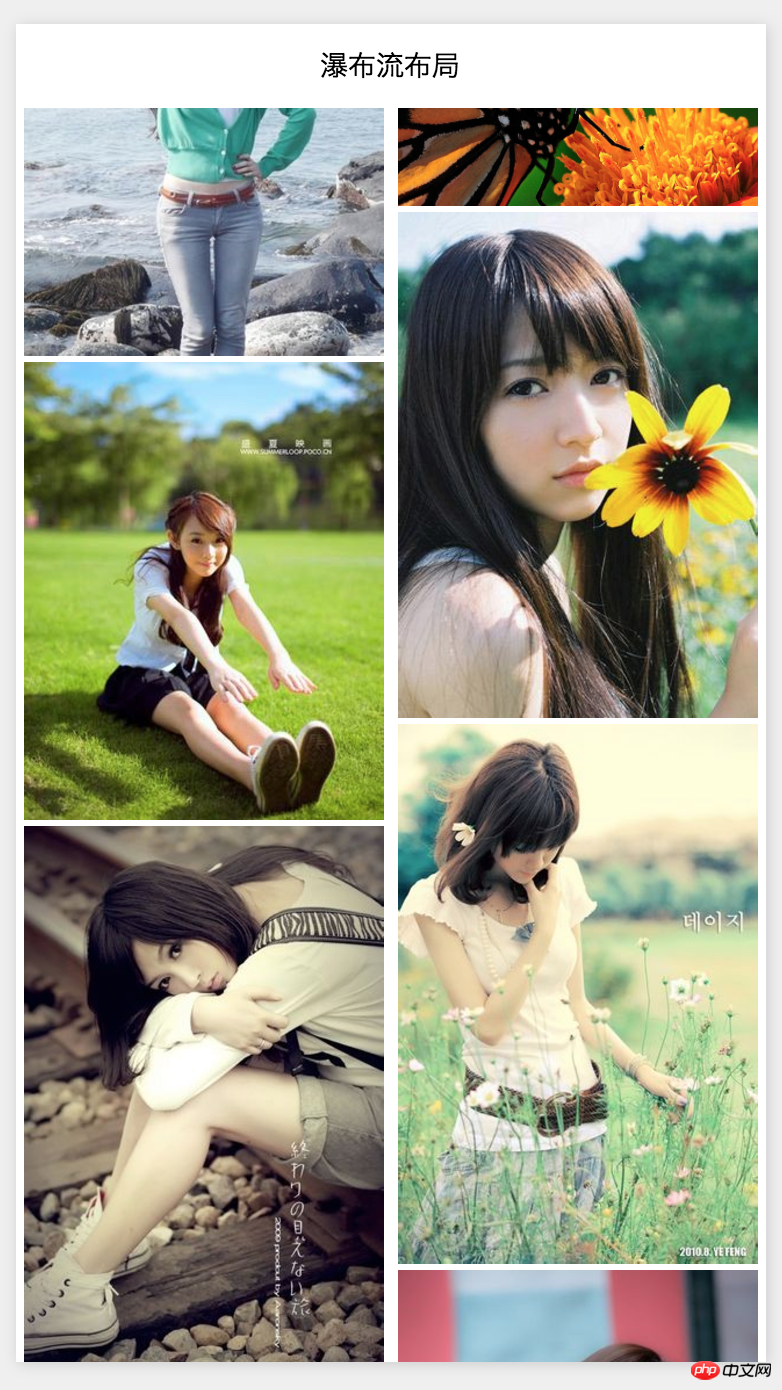微信小程序实现瀑布流布局和无限加载
瀑布流布局是一种比较流行的页面布局方式,最典型的就是Pinterest.com,每个卡片的高度不都一样,形成一种参差不齐的美感。
在HTML5中,我们可以找到很多基于jQuery之类实现的瀑布流布局插件,轻松做出这样的布局形式。在微信小程序中,我们也可以做出这样的效果,不过由于小程序框架的一些特性,在实现思路上还是有一些差别的。
今天我们就来看一下如何在小程序中去实现这种瀑布流布局:

小程序瀑布流布局
我们要实现的是一个固定2列的布局,然后将图片数据动态加载进这两列中(而加载进来的图片,会根据图片实际的尺寸,来决定到底是放在左列还是右列中)。
/* 单个图片容器的样式 */
.img_item {
width: 48%;
margin: 1%;
display: inline-block;
vertical-align: top;
}我们知道,在HTML中,我们要动态加载图片的话,通常会使用new Image()创建一个图片对象,然后通过它来动态加载一个url指向的图片,并获取图片的实际尺寸等信息。而在小程序框架中,并没有提供相应的JS对象来处理图片加载。其实我们可以借助wxml中的
<!-- 在页面上放一个隐藏区域,并用image组件去加载一个或多个图片资源 -->
<view style="display:none">
<image wx:for="{{images}}" wx:key="id" id="{{item.id}}" src="{{item.pic}}" bindload="onImageLoad"></image>
</view>我们可以在Page中通过数据绑定,来传递要加载的图片信息到wxml中,让
我们来看一下Page文件中定义的onImageLoad函数。在其中,我们可以从传入的事件对象e上,获取到
let col1H = 0;
let col2H = 0;
Page({
data: {
scrollH: 0,
imgWidth: 0,
loadingCount: 0,
images: [],
col1: [],
col2: []
},
onLoad: function () {
wx.getSystemInfo({
success: (res) => {
let ww = res.windowWidth;
let wh = res.windowHeight;
let imgWidth = ww * 0.48;
let scrollH = wh;
this.setData({
scrollH: scrollH,
imgWidth: imgWidth
});
//加载首组图片
this.loadImages();
}
})
},
onImageLoad: function (e) {
let imageId = e.currentTarget.id;
let oImgW = e.detail.width; //图片原始宽度
let oImgH = e.detail.height; //图片原始高度
let imgWidth = this.data.imgWidth; //图片设置的宽度
let scale = imgWidth / oImgW; //比例计算
let imgHeight = oImgH * scale; //自适应高度
let images = this.data.images;
let imageObj = null;
for (let i = 0; i < images.length; i++) {
let img = images[i];
if (img.id === imageId) {
imageObj = img;
break;
}
}
imageObj.height = imgHeight;
let loadingCount = this.data.loadingCount - 1;
let col1 = this.data.col1;
let col2 = this.data.col2;
//判断当前图片添加到左列还是右列
if (col1H <= col2H) {
col1H += imgHeight;
col1.push(imageObj);
} else {
col2H += imgHeight;
col2.push(imageObj);
}
let data = {
loadingCount: loadingCount,
col1: col1,
col2: col2
};
//当前这组图片已加载完毕,则清空图片临时加载区域的内容
if (!loadingCount) {
data.images = [];
}
this.setData(data);
},
loadImages: function () {
let images = [
{ pic: "../../images/1.png", height: 0 },
{ pic: "../../images/2.png", height: 0 },
{ pic: "../../images/3.png", height: 0 },
{ pic: "../../images/4.png", height: 0 },
{ pic: "../../images/5.png", height: 0 },
{ pic: "../../images/6.png", height: 0 },
{ pic: "../../images/7.png", height: 0 },
{ pic: "../../images/8.png", height: 0 },
{ pic: "../../images/9.png", height: 0 },
{ pic: "../../images/10.png", height: 0 },
{ pic: "../../images/11.png", height: 0 },
{ pic: "../../images/12.png", height: 0 },
{ pic: "../../images/13.png", height: 0 },
{ pic: "../../images/14.png", height: 0 }
];
let baseId = "img-" + (+new Date());
for (let i = 0; i < images.length; i++) {
images[i].id = baseId + "-" + i;
}
this.setData({
loadingCount: images.length,
images: images
});
}
})这里是显示在两列图片的wxml代码,我们可以看到在 好了,挺简单的一个例子,如果你有更好的方法,不吝分享一下哦。 以上是微信小程序实现瀑布流布局和无限加载的详细内容。更多信息请关注PHP中文网其他相关文章!<scroll-view scroll-y="true" style="height:{{scrollH}}px" bindscrolltolower="loadImages">
<view style="width:100%">
<view class="img_item">
<view wx:for="{{col1}}" wx:key="id">
<image src="{{item.pic}}" style="width:100%;height:{{item.height}}px"></image>
</view>
</view>
<view class="img_item">
<view wx:for="{{col2}}" wx:key="id">
<image src="{{item.pic}}" style="width:100%;height:{{item.height}}px"></image>
</view>
</view>
</view>
</scroll-view>

热AI工具

Undresser.AI Undress
人工智能驱动的应用程序,用于创建逼真的裸体照片

AI Clothes Remover
用于从照片中去除衣服的在线人工智能工具。

Undress AI Tool
免费脱衣服图片

Clothoff.io
AI脱衣机

AI Hentai Generator
免费生成ai无尽的。

热门文章

热工具

记事本++7.3.1
好用且免费的代码编辑器

SublimeText3汉化版
中文版,非常好用

禅工作室 13.0.1
功能强大的PHP集成开发环境

Dreamweaver CS6
视觉化网页开发工具

SublimeText3 Mac版
神级代码编辑软件(SublimeText3)

热门话题
 如何使用Vue构建无限滚动和瀑布流布局?
Jun 27, 2023 pm 01:32 PM
如何使用Vue构建无限滚动和瀑布流布局?
Jun 27, 2023 pm 01:32 PM
Vue.js是一种流行的JavaScript框架,它使开发者可以轻松地创建动态,响应式的Web应用程序。其中,尤其以其强大的组件化开发能力而备受开发者的青睐。而无限滚动和瀑布流布局已经成为现代Web开发中不可或缺的特性之一。本文旨在介绍如何使用Vue.js,结合一些第三方库,实现无限滚动和瀑布流布局的功能。实现无限滚动无限滚动(Infinit
 如何使用HTML和CSS实现瀑布流商品展示布局
Oct 21, 2023 am 09:25 AM
如何使用HTML和CSS实现瀑布流商品展示布局
Oct 21, 2023 am 09:25 AM
如何使用HTML和CSS实现瀑布流商品展示布局瀑布流布局是一种常见的网页设计方式,特点是呈现出错落有致、动态有序的视觉效果。在商品展示网页中应用瀑布流布局可以提高商品的展示效果,吸引用户的注意力。本文将介绍如何使用HTML和CSS实现瀑布流商品展示布局,并提供具体的代码示例。一、HTML结构首先,我们需要搭建一个基本的HTML结构,以容
 如何使用CSS3的flex属性,构建瀑布流布局效果?
Sep 09, 2023 am 08:39 AM
如何使用CSS3的flex属性,构建瀑布流布局效果?
Sep 09, 2023 am 08:39 AM
如何使用CSS3的flex属性,构建瀑布流布局效果?在网页设计中,瀑布流布局(WaterfallLayout)是一种常见且流行的页面布局方式。它的特点是将内容以不规则的列数和行高呈现,营造出瀑布流般的美感。在过去,实现瀑布流布局需要使用复杂的JavaScript代码来计算元素的位置和尺寸。然而,随着CSS3的发展,我们可以利用其强大的flex属性来更加简单
 使用CSS实现响应式卡片瀑布流布局的技巧
Nov 21, 2023 am 08:26 AM
使用CSS实现响应式卡片瀑布流布局的技巧
Nov 21, 2023 am 08:26 AM
使用CSS实现响应式卡片瀑布流布局的技巧随着移动设备的普及和网页内容的多样化,响应式设计已经成为现代web开发的基本要求之一。其中,卡片式布局和瀑布流布局都逐渐成为广受欢迎的设计风格。本文将介绍如何使用CSS实现一个响应式的卡片瀑布流布局,并提供具体的代码示例。一、HTML结构首先,我们需要在HTML中定义一组卡片的结构,例如使用<ul>和<
 如何使用Css Flex 弹性布局实现瀑布流布局
Sep 27, 2023 pm 04:22 PM
如何使用Css Flex 弹性布局实现瀑布流布局
Sep 27, 2023 pm 04:22 PM
如何使用CSSFlex弹性布局实现瀑布流布局随着网页设计的不断发展,瀑布流布局成为了一种非常流行的页面布局方式。与传统的网格布局不同,瀑布流布局能够自适应屏幕大小,并且呈现出独特的流动感。在本文中,我们将介绍如何使用CSSFlex弹性布局来实现瀑布流布局,并提供具体的代码示例。CSSFlex弹性布局是一种强大的布局模型,它通过在容器元素上应用di
 利用uniapp实现瀑布流布局效果
Nov 21, 2023 am 10:25 AM
利用uniapp实现瀑布流布局效果
Nov 21, 2023 am 10:25 AM
利用Uniapp实现瀑布流布局效果瀑布流布局是一种常见的网页布局形式,它的特点是将内容按照不规则的列数排列,形成类似瀑布流式的效果。在移动端开发中,利用Uniapp框架可以轻松实现瀑布流布局效果。本文将介绍如何利用Uniapp实现瀑布流布局,并提供具体的代码示例。一、创建Uniapp项目首先,我们需要在电脑上安装好HbuilderX开发工
 如何使用HTML和CSS实现瀑布流布局
Oct 24, 2023 am 09:33 AM
如何使用HTML和CSS实现瀑布流布局
Oct 24, 2023 am 09:33 AM
如何使用HTML和CSS实现瀑布流布局瀑布流布局(WaterfallLayout)是一种常见的网页布局方式,它可以使网页内容呈现出像瀑布流一样的效果,每一列的高度可以不同,让网页看起来更加有趣和动感。在这篇文章中,我们将介绍如何使用HTML和CSS来实现瀑布流布局,并附上具体的代码示例。首先,我们来了解一下所需的HTML结构。为了实现瀑布流布局,我们需要使
 解决win10搜索框无限加载的方法
Dec 26, 2023 pm 10:05 PM
解决win10搜索框无限加载的方法
Dec 26, 2023 pm 10:05 PM
用户在使用win搜索框,出现了搜索东西一直在加载,显示不出东西的情况,一般打开WindowsPowerShell(管理员)输入指令即可解决,下面一起看看详细win10搜索框无限加载的解决方法吧。win10搜索框无限加载:1、点击开始菜单——找到WindowsPowerShell文件夹。2、点击WindowsPowerShell文件——右击WindowsPowerShell——选择以管理员身份运行。3、在命令窗口输出指令。Get-AppXPackage-NameMicrosoft.Windows.






